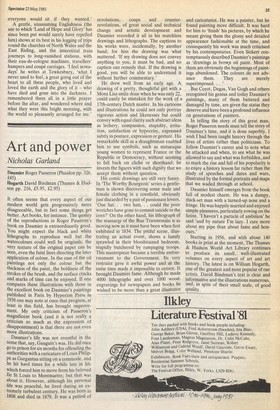Art and power
Nicholas Garland
Daumier Roger Passeron (Phaidon pp. 326, £45) Hogarth David Bindman (Thames & Hudson pp. 216, £5.95, £2.95) It often seems that every aspect of our modern world gets progressively more disagreeable, but in fact some things get better. Art books, for instance. The quality of the reproductions in Roger Passeron's book on Daumier is extraordinarily good. You might expect the black and white lithographs to reproduce well but the watercolours could well be originals; the very texture of the original paper can be seen, even the faint lines directing the later application of colour. In the case of the oil Paintings not only the colour but the thickness of the paint, the boldness of the strokes of the brush, and the surface cracks and marks of time can be enjoyed. If one compares these illustrations with those in the excellent book on Daumier's paintings published in Paris by Hyperion Press in 1938 one may note at once that progress, at least in this field, has brought improvement. My only criticism of Passeron's magnificent book (and it is not really a criticism so much as the expression of disappointment) is that there are not even more illustrations.
Daumier's life was not eventful in the sense that, say, Gauguin's was. He did once go to prison for six months for offending the authorities with a caricature of Louis Philippe as Gargantua sitting on a commode, and he hit hard times for a while late in life which forced him to move from his beloved Ile St Louis to Montmartre; but that was about it. However, although his personal life was peaceful, he lived during an extremely turbulent century. He was born in 1808 and died in 1879. It was a period of revolutions, coups and counterrevolutions, of great social and technical change and artistic development and Daumier recorded it all in his matchless drawings and lithographs. The captions to his works were, incidentally, by another hand; for him the drawing was what mattered. `If my drawing does not convey anything to you, it must be bad, and no caption can remedy that. If the drawing is good, you will be able to understand it without further commentary.'
He drew well from an early age. A, drawing of a pretty, thoughtful girl with a Mona Lisa smile done when he was only 22, could easily be mistaken for the work of a 17th-century Dutch master. In his cartoons and illustrations he could not only portray vigorous action and likenesses but could convey with equal clarity such abstract ideas as lechery, compassion, stupidity, irritation, satisfaction or hypocrisy, expressed subtly in posture, expression or gesture. His remarkable skill as a draughtsman enabled him to use symbols, such as statuesque young women to represent France or the Republic or Democracy, without seeming to fall back on cliché or shorthand; he invests the figures with such dignity that we accept them without question.
His comic drawings are still very funny. In 'The Worthy Bourgeois' series a gentleman is shown discovering some male and female clothing in a cornfield, obviously just discarded by a pair of passionate lovers. `One hat. . . two hats. . could the poor wretches have gone to commit suicide in the corn?' On the other hand, his lithograph of the massacre of the Rue Transnonain is as moving now as it must have been when first exhibited in 1834. The pitiful scene, illustrating an actual event, shows a family sprawled in their bloodstained bedroom, stupidly butchered by rampaging troops. This masterpiece became a terrible embarrassment to the Government. Its very restraint gave it awful power and at the same time made it impossible to censor. It brought Daumier fame. Although he made 4000 lithographs and over 1000 woodengravings for newspapers and books he wished to be more than a great illustrator and caricaturist. He was a painter, but he found painting more difficult. It was hard for him to 'finish' his pictures, by which he meant giving them the glossy and detailed appearance fashionable at the time, and consequently his work was much criticised by his contemporaries. Even Sickert contemptuously described Daumier's paintings as 'drawings in brow.n oil paint. Most of them are obviously the beginnings of paintings abandoned. The colours do not advance them. They are merely superimposed.
But Corot, Degas, Van Gogh and others recognised his genius and today Daumier's paintings, many of them battered and damaged by time, are given the status they deserve and have been a profound influence on generations of painters.
In telling the story of this great man, Roger Passeron needs must tell the story of Daumier's time, and it is done superbly. I wish I had been taught history through the lives of artists rather than politicians. To follow Daumier's career and to note what he attacked and when, to see what he was allowed to say and what was forbidden, and to mark the rise and fall of his popularity is to enjoy a history lesson far richer than the study of speeches and dates and wars, illustrated by the formal portraits and maps that we waded through at school.
• Daumier himself emerges from the book full of modest charm. He was a dumpy, • thick-set man with a turned-up nose and a fringe. He was happily married and enjoyed simple pleasures, particularly rowing on the Seine. 'I haven't a particle of ambition' he said `and by nature I'm lazy. I care more about my pipe than about fame and honours.'
Starting in 1956, and with about 140 books in print at the moment, The Thames & Hudson World Art Library continues to produce its small, well-illustrated volumes on every aspect of art and art history. The latest is on William Hogarth, one of the greatest and most popular of our artists. David Bindrnan's text is clear and informative and the illustrations numerous, and, in spite of their small scale, of good quality.










































 Previous page
Previous page